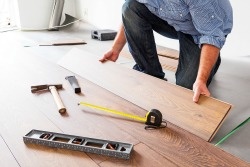 Sunken in or uneven floors can be a nuisance for homeowners, and in some cases, it can be downright dangerous. What many homeowners don’t realize is that many problems associated with hardwood floors can be traced back to the subfloor below it. Preparing the subfloor correctly is critical to a seamless installation, and poorly installed subfloors can cause problems for homeowners down the road. Here are some common problems associated with subfloors and solutions to help you restore them:
Sunken in or uneven floors can be a nuisance for homeowners, and in some cases, it can be downright dangerous. What many homeowners don’t realize is that many problems associated with hardwood floors can be traced back to the subfloor below it. Preparing the subfloor correctly is critical to a seamless installation, and poorly installed subfloors can cause problems for homeowners down the road. Here are some common problems associated with subfloors and solutions to help you restore them:
- Cupping of a floor occurs when the edges of the floorboards are raised up, creating a “cup” in the middle. Varying levels of humidity in the floorboards and subfloors typically causes cupping. When cupping occurs, the bottom sides of the floor planks absorb a greater amount of moisture than the top, which causes the top and bottom to expand to different amounts – resulting in a “cup” shape.
- It’s common for older homes to have a floor that creaks or makes other noises when walked on. It’s not uncommon for homeowners to ignore these noises because of this. However, it’s important to understand that a creaking noise could also mean that the subfloor isn’t properly secured to the underlying joists. Additionally, creaking may indicate that the wrong thickness of plywood or OSB was used. If you notice a creaking floor, it’s important to properly examine the subfloor to determine the cause of the noises.
- There are several different causes of an uneven floor. It’s possible that the subfloor is warped and loose, but it could also mean that the floor joists may be warped or split. There’s also a chance that the foundation or support walls may have settled over time, causing an uneven floor. Before making a diagnosis, inspect the subfloor and look for each of these issues to determine what needs to be fixed.
- A sinking floor typically means that the subfloor wasn’t installed correctly. If the floor has too much give to it, or if it feels “spongy,” it could also mean that the subfloor is old and needs to be replaced. Excessive moisture can rot the joist, causing certain areas of the floor to sag. The best course of action for a sinking floor is to replace the subfloor below it.
- Although this isn’t usually an issue with the subfloor itself, we still felt it was important to include it. Slanting is usually due to house and/or foundation settling problems. The best way to remedy this situation is to remove the subfloor and add joists to level. Then, you can go back and install a new subfloor.
The SubLoc® PRO SCRAIL® was developed to avoid subfloor squeaks. The upper threads grab into the deckboard and prevent micro movement of the wood even in the event of wood shrinkage.
The aggressive double threads are designed for squeak-less subfloors because no smooth shank between the upper and lower threads prevents board movement that can lead to unwanted noises. And the good news is that the SubLoc® PRO SCRAIL® offers the hold of a screw with the ease of use of a nail and can be quickly driven with a pneumatic nailer.
Looking for even more tips on how to install floors perfectly every time? Download the eGuide: The Key to a Squeak-less Subfloor
.svg.png)

